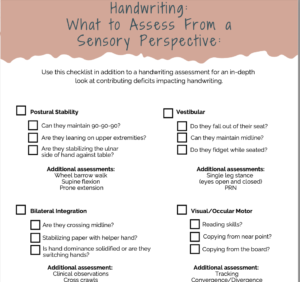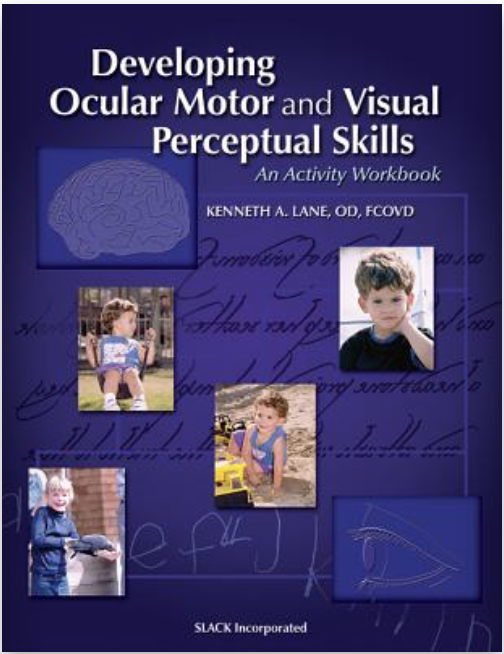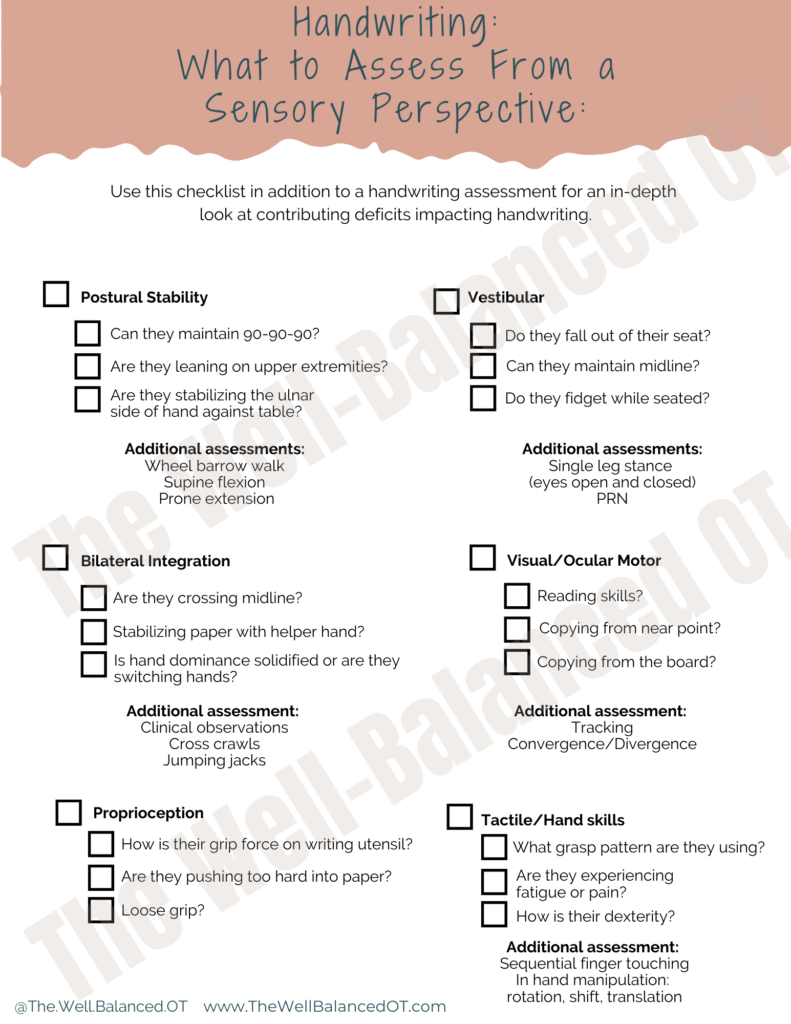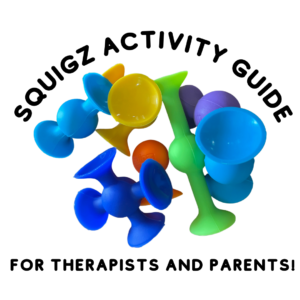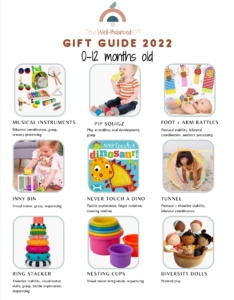It’s that time of year where OTs are getting lots of referrals for handwriting concerns. Handwriting is a skill that starts to develop at birth. Seriously! The child might not start writing letters until they are 5 or 6 but there are so many pre-requisite skills that develop prior. When there are handwriting concerns, we must look at all of the skills, not just the written work. To make it a little easier on you, I’ve created a free checklist. It includes the areas to assess during evaluations and different assessment tools to use.
Postural Stability + Development of the Core
Our ability to use a pencil with precision is determined by the strength and stability of our core. Postural stability is how strong and stable our core, back, chest, and shoulder girdle are as a unit. Starting with Tummy Time as an infant they begin to strengthen their back and neck muscles. This progresses through rolling, crawling, and walking. Each of these milestones helps develop our postural stability.
Milestones

You might have heard that it’s okay if a child skips crawling, but that is false. Crawling helps develop shoulder stability which is necessary for fine motor tasks. Standing at a chalkboard to draw? You are using shoulder stability to hold your arm up. Playing with magnets on the fridge? Again, the shoulder girdle is what is enabling your arm to place each piece. When it is underdeveloped we fatigue quickly, avoid the task, and frustrate to the point of meltdown.

Crawling also contributes to the development of the arches in our hands. These arches allow us to grasp objects in our hands and with our fingers. It also promotes strengthening the pinky side of the hand. You’ll notice that crawling typically develops around 7-9 months, which is when our grasp patterns become more refined and precise. The time we’ve spent in crawling positions leads to a stronger, more efficient body.
If a child skips the crawling milestone, it doesn’t mean you can’t still practice it. Crawling through tunnels, under tables, and up slides are all fun ways to encourage the position and strengthen the body. Incorporate it into obstacle courses for the slightly older ones and they’ll have a blast!
Seated Posture
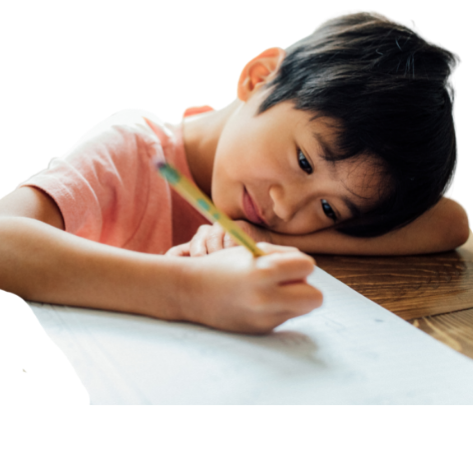
When sitting, our feet should be flat on the floor and our ankles, knees, and hips are at a 90-degree angle. Our core should be strong enough to hold our chest and head high without slumping over. Our hands and fingertips should move as individual units rather than whole arm movements to manipulate a writing utensil. When we are weak, we need MORE support. Not LESS. If a teacher is worried about a student’s handwriting and you see they are sitting on a yoga ball, immediately recommend a different seat. I wrote a blog post all about it here. A weak core can contribute to poor handwriting, visual attention, and engagement.
The Vestibular System
Our Vestibular system is one of the first sensory systems to begin development in utero. Through the birthing parent’s daily movements, the fetus begins to process that experience. They develop balance, postural control, and muscle tone as they are exposed to gravity. The body must learn how to move against it as they move through developmental milestones.
The vestibular system continues to mature enabling the body to sit upright without falling over (as opposed to floppy/low tone). If a child is under-responsive to vestibular input, they may fall out of their seat, fidget, or lean against the desk. All of which would impact a child’s handwriting success. I often recommend these students engage in movement activities prior to seated work. Inversion, jumping, or balancing are great options!
The Visual System + Ocular Motor Control
Visual Acuity measures how well we see, but it is not the only thing impacting our vision. Visual perceptual skills, ocular motor skills, and visual-motor skills also contribute. Starting in the first year of life, newborns learn to track faces and objects. They begin to watch their hands explore the world and perceive differences in objects.
Visual Perceptual Skills: The ability to process what we see
- Visual Memory: Writing letters from memory, including orientation and letter sequence
- Visual Discrimination: The ability to tell one letter from another
- Visual Spatial Organization: Impacts size, spacing, or orientation.
- Visual Closure: A letter O is still a letter O, even if part of it is missing or not connecting
- Visual Sequential Memory: Recalling letters in order.
Ocular Motor Skills: The movements of our eyes, ideally working together
The vestibular paired with the visual system stabilizes our neck and head. This allows our eyes to focus and scan our environment without falling over and tripping. When we apply this skill to handwriting, it allows us to read, copy words from the board or a sheet of paper without losing place.
There is a great book by Kenneth Lane called “Developing Ocular Motor and Visual Perceptual Skills” that have a ton of activities to help strengthen these areas! I highly recommend it!
Visual Motor Skills: Hand eye coordination
At about 2 months an infant starts to notice they have hands, especially since they fit perfectly into the mouth. Between 1-4 months you’ll notice the infant frequently moving in and out of this position:
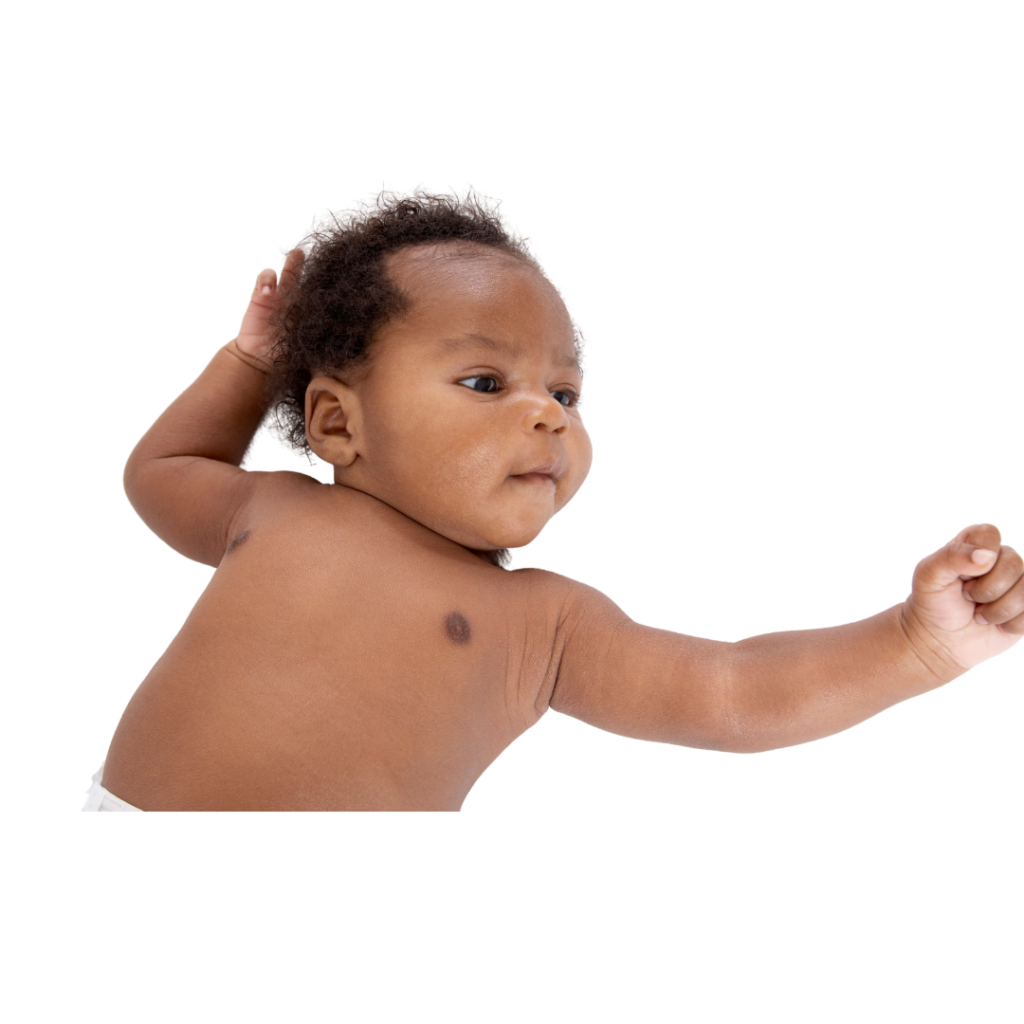
It’s called ATNR and it is a primitive reflex that helps develop hand-eye coordination (plus a ton of other things). As the arm extends, the child’s eyes focus on the hand. This is just the beginning stages of them being able to string beads, fasten buttons and write letters.
If you want to learn more about Reflexes I recommend looking into the MNRI courses or the one by Sensational Brain. I have not taken the Sensational Brain one, but have heard it’s great. A note about reflex training: Many school-based therapists do not have the amount of direct time with the student needed to fully integrate a reflex. It is still beneficial to know, incorporate into activities and educate the parents.
Bilateral Integration
It’s our ability to use both sides of the body in the same or complementary ways. For example, using both hands to roll play-doh. Or, using one hand to stabilize a container and the other to pull off the top. Is the student stabilizing their paper with their non-dominant hand? Does the student have a dominant hand they are using consistently when writing? Can the student cross midline?
Cross Crawls are a really easy activity to do in small environments and can help strengthen bilateral skills!
The Proprioceptive System
This sensory system is one of the most mysterious because few people outside of the medical world know it exists. Our proprioceptive system provides information on where the body is in space and how to move with good timing and force. As you can imagine, this can impact the way a child moves their hand and holds their pencil. When completing their evaluation look at their grip. Is it too loose or tight? Are they are pressing the pencil tip hard into the paper? Changing out the writing tool to a mechanical pencil or soft sketching pencil may do the trick to help this student.
The Tactile System and Grasp
Our ability to feel small items and tools in our hands contributes to how well we manipulate those objects. If this is a struggle, we will use our eyes to provide additional information to the brain. But when we are writing, should we be looking at hands? Nope, we should be looking at the tip of our pencil or glancing up to look at the board when copying. Freeing up their vision will allow them to write faster and smoother.

Take this time to also look at the grasp. We are looking for function, not perfection. The tripod grasp is the gold standard, but it isn’t the only grasp pattern that will provide legible handwriting.
Get Your Free Checklist!
I have a free, easy to print checklist in my Freebie Vault! It will remind you exactly what to observe and assess when this concern arises. Sign up for my email list, then download this and any other resources available!
Additional Resources:
Development of Early Handwriting: Visual-Motor Control During Letter Copying
The relationship between a child’s postural stability and manual dexterity

